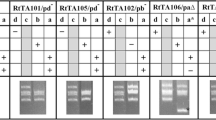Abstract
Gnotobiotic systems were used to assess the competitive abilities of bioluminescent Sinorhizobium meliloti strains L1 (RecA−) and L33 (RecA+) for growth and host plant nodulation in the presence of a reconstructed S. meliloti population. Three wild-type strains belonging to infective subgroups of a natural S. meliloti population were chosen as competitors in microcosm studies. Whereas the RecA+ strain L33 dominated the reconstructed population with respect to growth and alfalfa nodulation, the competitiveness of the RecA− strain L1 was reduced compared to that of one of the field strains, but comparable to that of the other field isolates. This result indicates that strain L1, despite its recA mutation, has the potential to compete successfully with a resident S. meliloti population after environmental release.
Similar content being viewed by others
Author information
Authors and Affiliations
Additional information
Received: 4 November 1996 / Received revision: 9 January 1997 / Accepted: 17 January 1997
Rights and permissions
About this article
Cite this article
Niemann, S., Pühler, A. & Selbitschka, W. Growth and nodulation competitiveness of Sinorhizobium meliloti L1 (RecA−) is less than that of its isogenic strain L33 (RecA+) but comparable to that of two S. meliloti wild-type isolates. Appl Microbiol Biotechnol 47, 525–529 (1997). https://doi.org/10.1007/s002530050967
Issue Date:
DOI: https://doi.org/10.1007/s002530050967




